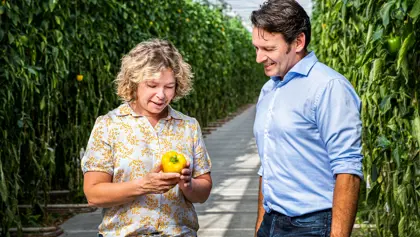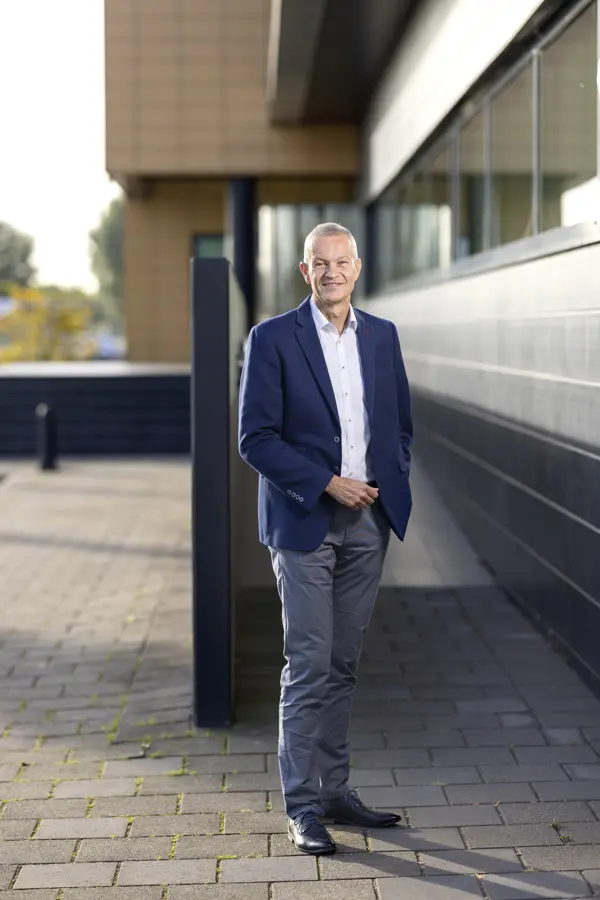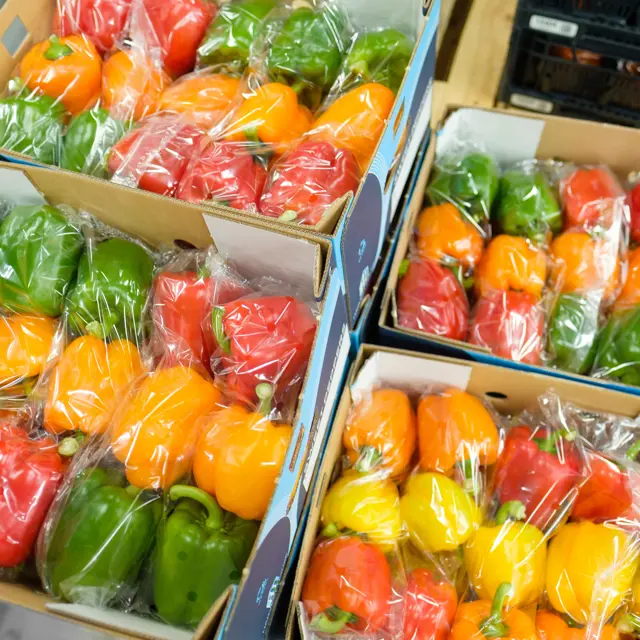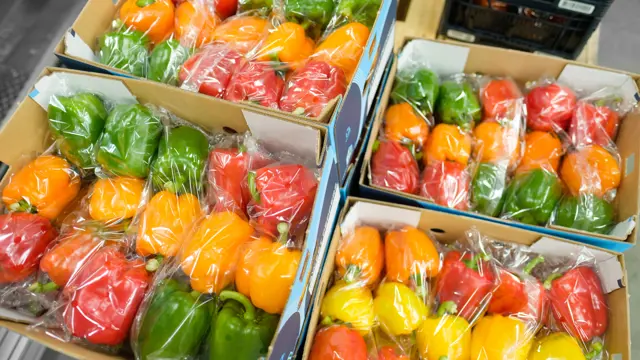More
Stories from our customers
This is how we help companies become more productive.
Harvest House: Data-driven strategy starts with integration
How quickly can you adapt if you want to supply a new supermarket tomorrow as a food supplier? Harvest House U.A. and its members can respond immediately to such an opportunity. The secret? An integration platform that connects every application like a Lego brick – accelerating the path to new markets. This technological foundation, combined with data-driven insights, a touch of AI, and thoughtful use of shadow IT, opens the gates to less waste, higher margins, and smarter business processes.

CFO René van Tatenhove explains how Harvest House uses technology as the foundation of their strategy.
With Azure Integration Services, the cooperative built a platform that accelerates growth and innovation. “You want to be able to adapt when the strategy demands it. Not having to start an IT project first,” says René. “IT should not slow down, but accelerate.”
As a link between its members and customers across Europe, Harvest House processes enormous amounts of data daily, from orders to quality measurements. Thanks to the integration platform, the organization can respond immediately to opportunities in new markets—without delay. “Whether it’s a retailer in France or a supermarket chain in Eastern Europe: we are ready to meet market demand in a customer-specific and market-oriented way.”
Three platform strategy
With the support of HSO, Harvest House has built its digital foundation along three smart, interconnected platforms: communication, data, and application development. Each platform plays a unique and strategic role.
1. The communication and integration platform
The hub of Harvest House's digital infrastructure. Here, systems, customers, and chain partners come together. From supermarket orders to systems of growers and packers – everything is connected through this platform. This ensures uniformity of information and data exchange, along with cybersecurity requirements. René explains: “Everything you have already built can be clicked onto the integration platform like Lego blocks; this way, you reuse each integration over and over again.”
Because the platform is set up as event-driven and API-first, it doesn’t matter which IT platform a supermarket or partner uses. Harvest House can establish connections flexibly, quickly, and securely – an essential condition for entering new markets without long preparation times. “It doesn’t really matter where you want to do business – France, Germany, the United Kingdom, Eastern Europe, or Portugal. If the integration platform is well established, we can quickly seize opportunities.”




2. The Business Intelligence Platform (data lake)
Insight is everything. With the Harvest House BI platform, Harvest House has a central data hub where data from various sources is brought together, cleaned, and made available. The goal: better forecasting, smarter planning, and making substantiated commercial decisions.
A practical example: the supply forecast. Where growers used to manually report how many kilos of tomatoes would come from the greenhouse, Harvest House now uses AI models combined with current data from the greenhouse, weather forecasts, and cultivation information.
René emphasizes the importance of this: “A few percent more reliable forecasts are worth tons.
It prevents waste, makes logistics better plannable, and ensures that we can switch to actions with supermarkets earlier.” The strength of this platform lies in the connection. Data is made insightful through dashboards in Power BI and forms the basis for steering within the commercial team. What is the supply? What is the demand? How do you smartly align them?
3. Power Automate Platform: encouraging managed shadow IT
Harvest House believes in innovation on the work floor. With the Power Automate Platform, employees get the tools to improve processes themselves – without being dependent on IT projects. Think of low-code apps and automations that employees set up themselves.
René sees the importance of this: “Especially young people in our organization see the possibilities of Power Automate and Power Apps. They build solutions themselves that speed up processes or improve insights.”
The IT department and HSO support this shadow IT with guidelines and assurance.
For business-critical applications, there is testing and support through Managed Services. Less critical applications may be developed independently within predefined standards. “We want to encourage innovation, but in a controlled manner. HSO helps us maintain that balance. This way, you prevent the organization from becoming dependent on one employee or Excel workbook.”


Bringing technology and organization together
HSO played a major role in realizing this foundation. “We have really taken a journey together to get to the right team, and that continues to require attention in this growth phase. People from HSO who understand our business over time – that is essential. HSO helped set up a stable development street with a test, acceptance, and production environment. HSO also thinks along with change management by implementing solutions in small, successful steps. “We often start small, with one customer or one week, and show that it works. Then we expand. That approach fits well with our organization.”
“We want to encourage innovation, but in a controlled manner. HSO helps us maintain that balance. This way, you prevent the organization from becoming dependent on one employee or Excel workbook.”



The bell pepper flow packs
Bell peppers in a flow pack must meet a minimum weight. Previously, a margin was built in, safe but costly. Nowadays, the packaging line is controlled with Power BI data and an AI model. The algorithm ensures a much more efficient mix in the bag – as close to that minimum as possible.
The strategy for implementing such innovative solutions at Harvest House is to start small and then let the results speak for themselves. René explains, “We started with one trial week. That immediately gave a 5% improvement. Then we rolled it out to several weeks. Now it runs year-round, and we expect a margin increase per flow pack.”
René cites more examples of results: “Because we now better know what comes out of the greenhouse, we can coordinate actions with supermarkets earlier. This prevents products from having to be sold in bulk at a low price – and reduces food waste.”
“You need a team that understands your business”
The collaboration between Harvest House and HSO is based on partnership. There is a joint roadmap, mutual understanding, and room to build innovation together. “You need to make sure the right people are at the table – people who bring knowledge of IT innovation and apply it together in how our business works. We have invested in that together.” HSO proactively thinks along with new applications, technologies, and ways to create value with existing data and processes. “We bring the business, HSO helps us smartly align the IT with it.”
A foundation for the future
The three platforms together form a solid foundation on which Harvest House can continue to build. In areas such as sustainability, AI, chain insight, or new markets. René looks ahead: “The foundation is in place. Now we can move forward with applications such as CO₂ apps, blockchain technology, real-time chain insight, and AI-supported predictions.”
More
Stories from our customers
This is how we help companies become more productive.
Would you also like to accelerate your digital transformation? Get in touch!
We, and third parties, use cookies on our website. We use cookies to keep statistics, to save your preferences, but also for marketing purposes (for example, tailoring advertisements). By clicking on 'Settings' you can read more about our cookies and adjust your preferences. By clicking 'Accept all', you agree to the use of all cookies as described in our privacy and cookie policy.
Purpose
This cookie is used to store your preferences regarding cookies. The history is stored in your local storage.
Cookies
Location of Processing
European Union
Technologies Used
Cookies
Expiration date
1 year
Why required?
Required web technologies and cookies make our website technically accessible to and usable for you. This applies to essential base functionalities such as navigation on the website, correct display in your internet browser or requesting your consent. Without these web technologies and cookies our website does not work.
Purpose
These cookies are stored to keep you logged into the website.
Cookies
Location of Processing
European Union
Technologies Used
Cookies
Expiration date
1 year
Why required?
Required web technologies and cookies make our website technically accessible to and usable for you. This applies to essential base functionalities such as navigation on the website, correct display in your internet browser or requesting your consent. Without these web technologies and cookies our website does not work.
Purpose
This cookie is used to submit forms to us in a safe way.
Cookies
Location of Processing
European Union
Technologies Used
Cookies
Expiration date
1 year
Why required?
Required web technologies and cookies make our website technically accessible to and usable for you. This applies to essential base functionalities such as navigation on the website, correct display in your internet browser or requesting your consent. Without these web technologies and cookies our website does not work.
Purpose
This service provided by Google is used to load specific tags (or trackers) based on your preferences and location.
Why required?
This web technology enables us to insert tags based on your preferences. It is required but adheres to your settings and will not load any tags if you do not consent to them.
Purpose
This cookie is used to store your preferences regarding language.
Cookies
Why required?
We use your browser language to determine which language to show on our website. When you change the default language, this cookie makes sure your language preference is persistent.
Purpose
This service is used to track anonymized analytics on the HSO.com application. We find it very important that your privacy is protected. Therefore, we collect and store this data anonymously on our own servers. This cookie helps us collect data from HSO.com so that we can improve the website. Examples of this are: it allows us to track engagement by page, measuring various events like scroll-depth, time on page and clicks.
Cookie
Purpose
With your consent, this website will load Google Analytics to track behavior across the site.
Cookies
Purpose
With your consent, this website will load the Google Advertising tag which enables HSO to report user activity from HSO.com to Google. This enables HSO to track conversions and create remarketing lists based on user activity on HSO.com.
Possible cookies
Please refer to the below page for an updated view of all possible cookies that the Google Ads tag may set.
Cookie information for Google's ad products (safety.google)
Technologies Used
Cookies
Purpose
With your consent, we use IPGeoLocation to retrieve a country code based on your IP address. We use this service to be able to trigger the right web technologies for the right people.
Purpose
With your consent, we use Leadfeeder to identify companies by their IP-addresses. Leadfeeder automatically filters out all users visiting from residential IP addresses and ISPs. All visit data is aggregated on the company level.
Cookies
Purpose
With your consent, this website will load the LinkedIn Insights tag which enables us to see analytical data on website performance, allows us to build audiences, and use retargeting as an advertising technique. Learn more about LinkedIn cookies here.
Cookies
Purpose
With your consent, this website will load the Microsoft Advertising Universal Event Tracking tag which enables HSO to report user activity from HSO.com to Microsoft Advertising. HSO can then create conversion goals to specify which subset of user actions on the website qualify to be counted as conversions. Similarly, HSO can create remarketing lists based on user activity on HSO.com and Microsoft Advertising matches the list definitions with UET logged user activity to put users into those lists.
Cookies
Technologies Used
Cookies
Purpose
With your consent, this website will load the Microsoft Dynamics 365 Marketing tag which enables HSO to score leads based on your level of interaction with the website. The cookie contains no personal information, but does uniquely identify a specific browser on a specific machine. Learn more about Microsoft Dynamics 365 Marketing cookies here.
Cookies
Technologies Used
Cookies
Purpose
With your consent, we use Spotler to measures more extensive recurring website visits based on IP address and draw up a profile of a visitor.
Cookies
Purpose
With your consent, this website will show videos embedded from Vimeo.
Technologies Used
Cookies
Purpose
With your consent, this website will show videos embedded from Youtube.
Cookies
Technologies Used
Cookies
Purpose
With your consent, this website will load the Meta-pixel tag which enables us to see analytical data on website performance, allows us to build audiences, and use retargeting as an advertising technique through platforms owned by Meta, like Facebook and Instagram. Learn more about Facebook cookies here. You can adjust how ads work for you on Facebook here.
Cookies
Purpose
With your consent, we use LeadInfo to identify companies by their IP-addresses. LeadInfo automatically filters out all users visiting from residential IP addresses and ISPs. These cookies are not shared with third parties under any circumstances.
Cookies
Purpose
With your consent, we use TechTarget to identify companies by their IP address(es).
Cookies
Purpose
With your consent, we use this service provided by uMarketingSuite to run A/B tests across the HSO.com application. A/B testing (also called split testing) is comparing two versions of a web page to learn how we can improve your experience.
Purpose
With your consent, we use this service provided by uMarketingSuite to personalize pages and content across the HSO.com application. Personalization helps us to tailor the website to your specific needs, aiming to improve your experience on HSO.com.
Purpose
With your consent, we use ZoomInfo to identify companies by their IP addresses. The data collected helps us understand which companies are visiting our website, enabling us to target sales and marketing efforts more effectively.
Cookies